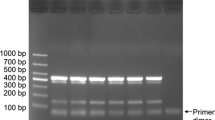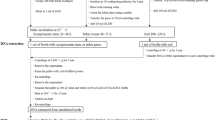Abstract
A multiplex PCR-ELISA protocol for detection ofClavibacter michiganensis subsp.sepedonicus (Cms) was developed that is based on primers for amplification of three single-copy, unique DNA sequences, Cms50, Cms72, and Cms85. The three sequences were simultaneously amplified from the genomes of all 42 strains of Cms that were tested including variant mucoid forms, but not from strains representing five related subspecies, andRathayibacter rathayi andRhodococcus faciens. The lowest limit of detection by gel electrophoresis was estimated to be approximately 300 CFU per mL when cells were spiked into potato core fluid, but sensitivity increases approximately 10-fold using PCR-ELISA. Inclusion of a sea anemone DNA fragment engineered so it could be amplified from the Cms72 primer set provided the simultaneous signal that the system functioned properly when any sample was free of the pathogen. The addition of hydrolyzed casein to the reaction mix was demonstrated to markedly reduce or eliminate inhibition of PCR by plant cell components or contaminants. Multiplex PCR-ELISA detection of Cms was determined to be verifiable for analysis of both stems and tubers based on the amplification of multiple sites in its genome, it provides absolute specificity, and it was more sensitive than detection based on gel electrophoresis of PCR products and serological approaches.
Similar content being viewed by others
Literature Cited
Ausubel FM, R Brent, RE Kingston, DD Moore, JG Seidman, JA Smith, and K Struhl (eds). 1992. Current Protocols in Molecular Biology. Wiley-Interscience, New York.
Baer D, and NC Gudmestad. 1993. Serological detection of nonmucoid strains ofClavibacter michiganensis subsp.sepedonicus in potato. Phytopathology 83:157–163.
Baer D, E Mitzel, J Pasche, and NC Gudmestad. 2001. PCR detection ofClavibacter michiganensis subsp. sepedonicus-infected tuber samples in a plate capture assay. Am J Potato Res 78:269–277.
Bertoni G, and D Mills 1987. A simple method to monitor growth of bacterial populations in leaf tissue. Phytopathology 77:832–835.
Borovkov AY, and MI Rivkin. 1997. XcmI-containing vector for direct cloning of PCR products. BioTechniques 22:812–814.
Crowley CF, and SH De Boer. 1982. Non-pathogenic bacteria associated with potato stems cross-react withCorynebacterium sepedonicum antisera in immunofluorescence. Am Potato J 60:661–669.
De Boer SH, and RJ Copeman. 1980. Bacterial ring rot testing with the indirect fluorescent antibody staining procedure. Am Potato J 57:457465.
De Boer SH, LJ Ward, X Li, and S Chittaranjan. 1995. Attenuation of PCR inhibition in the presence of plant compounds by addition of BLOTTO. Nucleic Acid Res 23:2567–2568.
De Boer SH, and A Wieczorek. 1984. Production of monoclonal antibodies toCorynebacterium sepedonicum. Phytopathology 74:1431–1434.
De Boer SH, A Wieczorek, and A Kummer. 1988. An ELISA test for bacterial ring rot of potato with a new monoclonal antibody. Plant Disease 72:874–878.
Dinesen IG, and SH De Boer 1995. Extraction ofClavibacter michiganensis subsp.sepedonicus from composite samples of potato tubers. Am Potato J 72:133–142.
Firrao G, and R Locci. 1994. Identification ofClavibacter michiganensis subsp.spedonicus using the polymerase chain reaction. Can J Microbiol 40:148–151.
Li X, and SH De Boer. 1995. Selection of polymerase chain reaction primers from an RNA intergenic spacer region of specific detection ofClavibacter michiganensis subsp.sepedonicus. Phytopathology 85:837–842.
Mills D, and BW Russell. 1997. A PCR ELISA-based detection method using three unique DNA fragments specific forClavibacter michiganensis subsp.sepedonicus Am Potato J 74:449. (abst.)
Mills D, BW Russell, and JW Hanus. 1997. Specific detection ofClavibacter michiganensis subsp.sepedonicus by amplification of three unique DNA sequences isolated by subtraction hybridization. Phytopathology 87:853–861.
Rademaker JLW, and JD Janse 1994. Detection and identification ofClavibacter michiganensis subsp.sepedonicus andClavibacter michiganensis subsp.michiganensis by nonradioactive hybridization, polymerase chain reaction, and restriction enzyme analysis. Can J Microbiol 40:1007–1018.
Sambrook J, EF Fritsch, and T Maniatis. 1989. Molecular Cloning: A Laboratory Manual. Cold Spring Harbor Laboratory, Cold Spring Harbor, NY.
Schaad NW, Y Berthier-Schaad, A Sechler, and D Knorr. 1999. Detection ofClavibacter michiganensis subsp.sepedonicus in potato tubers by BIO-PCR and an automated real-time fluorescence detection system. Plant Disease 83:1095–1100.
Schaad NW, SS Cheong, S Tamaki, E Hatziloukas, and NJ Panopoulos. 1995. A combined biological amplification (BIO-PCR) technique to detectPseudomonas syringae pv.phaseolicola in bean seed extracts. Pytopathology 85:243–248.
Schneider J, J Zhao, and CS Orser. 1993. Detection ofClavibacter michganensis subsp.sepedonicus by DNA amplification. FEMS Microbiol Lett 109:207–212.
Slack SA, A Kelman, and JB Perry. 1979. Comparison of three serodiagnostic assays for detection ofCorynebacterium sepedonicum. Phytopathology 69:186–189.
Souza-Dias JAC, P Russo, JA Berti, L Miller, and SA Slack. 1999. Simplified extraction method for ELISA and PCR detection of potato leafroll luteovirus primary infection in dormant potato tubers. Am J Potato Res. 76:209–213.
Vidaver AK. 1967. Synthetic and complex media for the rapid detection of fluorescence of phytopathogenicPseudomonads: Effect of the carbon source. Appl Microbiol 15:1523–1524.
Weller SA, JG Elphinstone, NC Smith, N Boonham, and DE Stead. 2000. Detection ofRalstonia solanacearum strains with a quantitative, multiple, real-time, fluorogenic PCR (TaqMan) assay. Appl Environ Microbiol 66:2853–2858.
Author information
Authors and Affiliations
Corresponding author
Rights and permissions
About this article
Cite this article
Mills, D., Russell, B.W. Parameters for specific detection ofClavibacter michiganensis subsp.sepedonicus in potato stems and tubers by multiplexed PCR-ELISA. Am. J. Pot Res 80, 223–233 (2003). https://doi.org/10.1007/BF02855358
Accepted:
Issue Date:
DOI: https://doi.org/10.1007/BF02855358




